Visiting Lascaux Cave and its magnificent prehistoric artworks
When you think of cave paintings, it’s most likely that what you picture in your mind’s eye is the cave paintings at Lascaux in France. They’re without a doubt the most well-known prehistoric artworks in the world.
Disclosure: This article contains affiliate links. Making a purchase through an affiliate link will mean a small commission for this website. This will not affect your price.
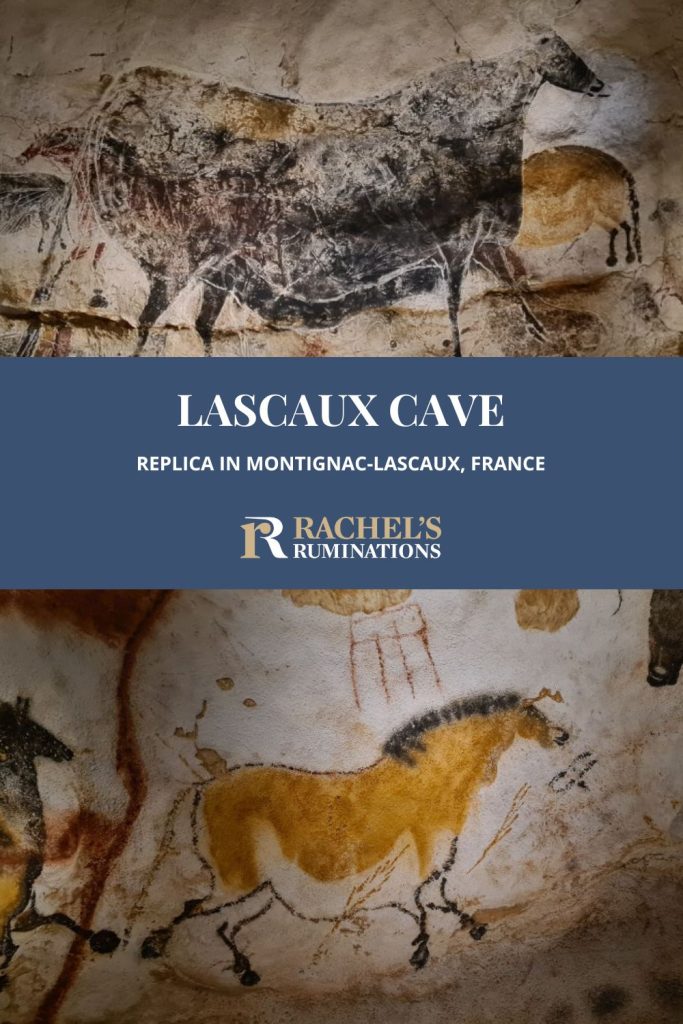
But before I tell you about visiting Lascaux Cave, I’ll start with the most basic question:
Can you visit Lascaux Cave?
The short answer is no. Lascaux Cave was discovered back in 1940 by some local boys. At the time, perhaps out of a desire for distraction at the deepening war, the discovery caused great excitement in the press and work began after the war to open the cave to the public. That happened in 1948, but archeological investigations continued into the 1960s, while all the while the number of yearly visitors grew.
By the 1950s, over a thousand people were visiting the cave every day, and the crowds gradually damaged the paintings. This had to do with the carbon dioxide they breathed out, along with their body heat and the humidity they introduced. Fungi, lichen and crystals began to grow on the walls, dimming the bright colors of the wall paintings.
The government decided to close the cave in 1963, allowing only a handful of visitors per day. The cave was cleaned and a system to process the air inside was installed, but apparently the cave still suffers from various sorts of mold, as well as damage from attempts to clean it. It was completely closed in 2008 and nowadays the fungus seems to be under control, though not entirely gone. Only a few scientists are allowed in the cave per month.
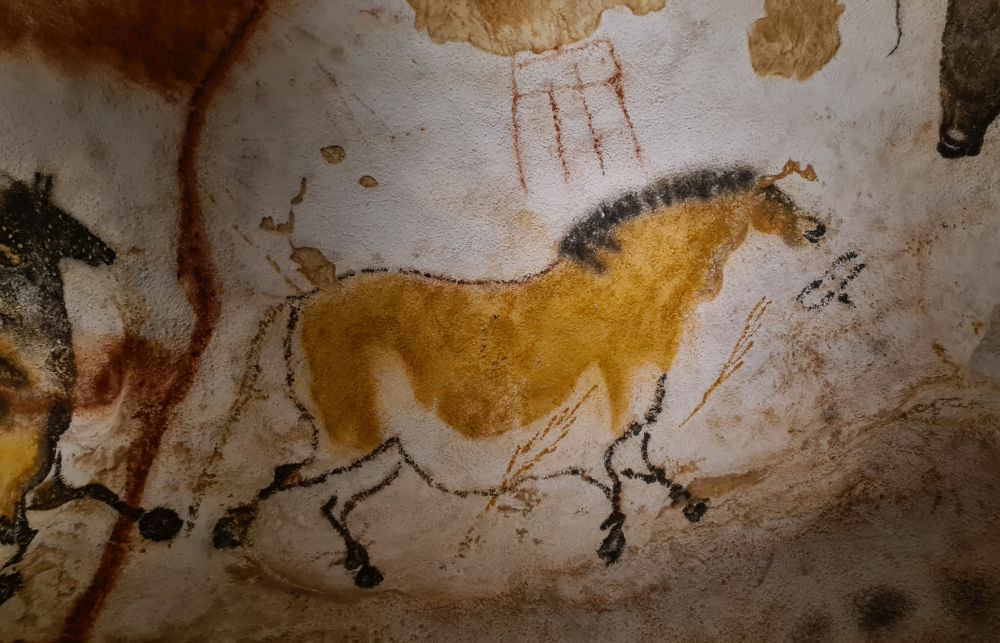
So what is there to visit at Lascaux?
Since there continues to be so much interest in the cave, it’s been reproduced. In fact, it’s been reproduced twice.
Opened in 1983, the Lascaux II site is near the original cave. It displays reproductions of two parts of the cave: the Great Hall of the Bulls and the Painted Gallery.
We visited Lascaux IV, which is a life-sized and complete replica of the cave, including all of the hundreds of prehistoric artworks. It’s also not far from the original cave. And it was more or less on our way from Bordeaux to the Burgundy region.
TLDR: It’s definitely worth visiting Lascaux Cave.
(And, by the way, there is a Lascaux III, but that’s a traveling exhibition.)
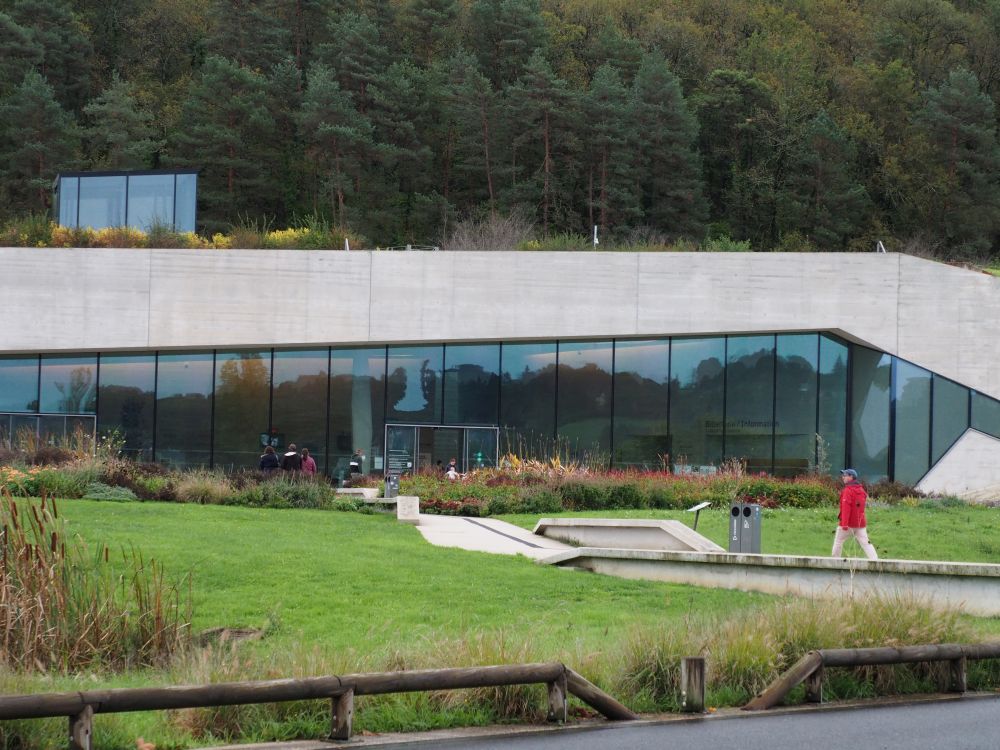
Lascaux IV: the International Center for Cave Art
Opened in 2016, Lascaux IV, also sometimes listed as the International Center for Parietal Art, is housed in a very modernistic concrete building set into a hill. Visitors move through a series of corridors and rooms – one of which shows a short film showing how the Vézère Valley looked 20,000 years ago, when the paintings were done, and how it looks today. It’s not much different except for the sorts of animals you see grazing.
The film, though, is just a teaser. The centerpiece of Lascaux IV is the replica cave. It is so realistic that I started wondering if I’d misunderstood – maybe this is the real cave?
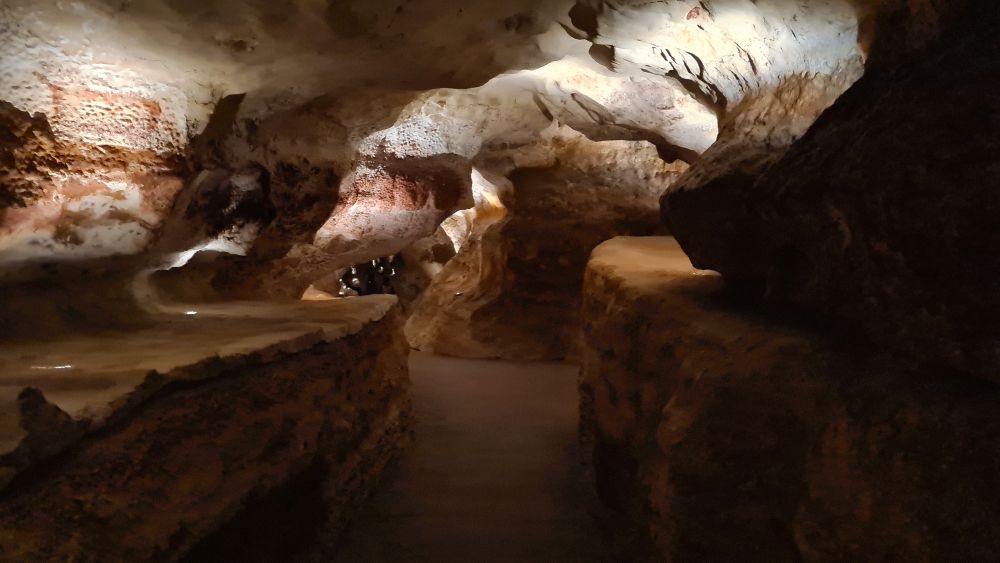
An audio guide we received at the door told us more about the painting we were seeing as we moved through the cave. It was fascinating, and I felt a sense of wonder at the quality – and yet the familiarity – of the images we saw.
Most of the images are of animals: mostly horses, stags, aurochs (black bulls), and bison. Some are line drawings, while others have been filled in with colors by blowing pigments through a tube or dabbing them on. Some of them are depicted as if they are in motion – a sort of animation expressed by painting their heads more than once, in different positions. Many of the images are life-sized.
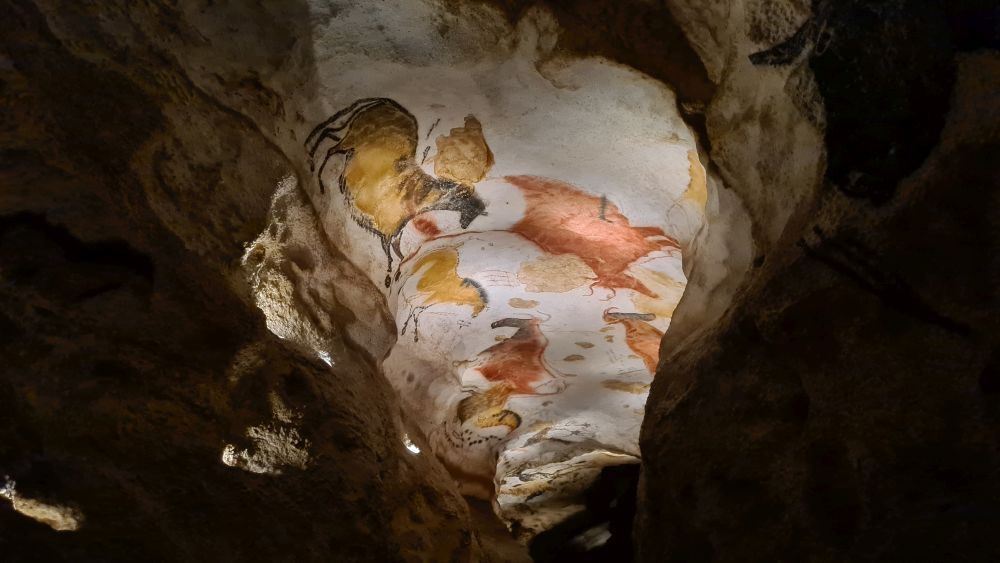
There are also various rather puzzling geometric figures (See the photo above of the horse and notice the figure above it.) and only one single human figure.
Some of the images are in beautiful condition. Some are barely visible, particularly the many images covering the surface of the section called the Apse. This is a dome-shaped area in the ceiling which the artist, 20,000 years ago, must have painted while using a scaffolding of some sort.
Book your tickets ahead of time here.
What do the paintings at Lascaux mean?
No one knows, but there are theories. They might have been telling the stories of successful hunts. Or perhaps they were drawn ahead of time to ensure that a hunt would be successful. Or they may have been part of some sort of ritual.
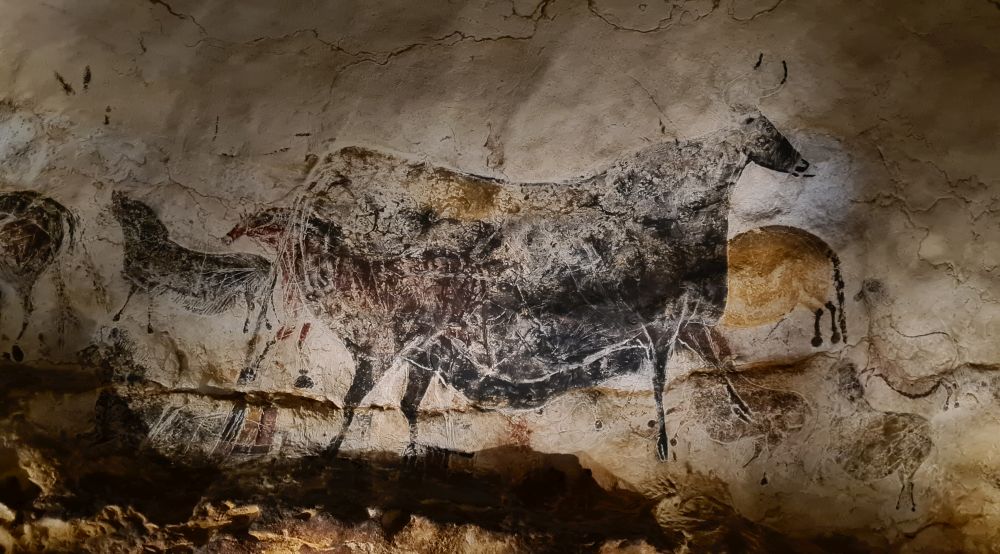
The Lascaux atelier
Once we exited the cave, we came to an “atelier.” This large room contains more replicas of sections of the cave, but in pieces: a sort of highlights collection. What’s really clever about this is that most of them are animated. In other words, as you listen to your audio device explain that particular segment, the images light up as they are discussed. Here, for example, is where you’ll get a much better idea of what drawings are on the Apse. It’s like the cave, but enhanced.
Also in the atelier are short videos about the cave’s history since its discovery, and an interactive game that allows visitors to try their hand (electronically) at drawing the cave paintings with the same material.
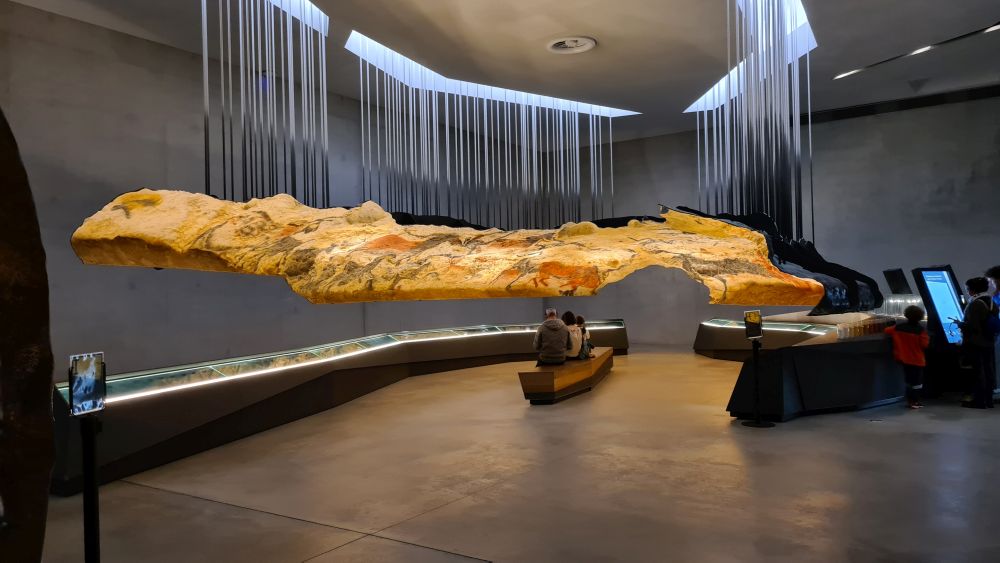
There’s also a section that explains some of the artifacts found inside the cave: arrowheads and spearheads of stone, oil lamps, also of stone, and spear shafts made of bone.
Other sections of the center include a theater and a cinema, where you can add to your understanding of the cave and its importance.
It’s just a copy. Why visit?
Because it’s an excellent copy, so real that it might as well be the actual cave. And visiting this Lascaux Cave replica is the closest you’ll ever get to this astounding prehistoric art.
There are plenty of hotels in the area near Lascaux Cave. Lascaux IV (Lascaux International Center of Parietal Arts) is marked on the map below, along with nearby hotels. Zoom out to see more options.
Some tips for visiting Lascaux Cave
There are other sites in the vicinity, all part of a UNESCO site called “Prehistoric Sites and Decorated Caves of the Vézère Valley.” Some are closed to the public, while about 10 sites are open only for guided tours. The general information website is only in French, so use Google Translate.
I only went to a cave called Le Grand Roc and some cave dwellings called Le Village de la Madeleine. Neither was anywhere near as impressive as Lascaux. The Grand Roc cave doesn’t have any cave paintings; it’s interesting if you like to see a cavern full of stalactites and stalagmites. La Madeleine doesn’t either. It’s a place where prehistoric people lived for part of the year in caves, but those caves are closed to visitors. What there is to see at La Madeleine has to do with later inhabitants: people who lived there in the Middle Ages.
The best way to get to Lascaux or any other sites is by car. Compare rental car prices here.
The Lascaux IV building is fully wheelchair accessible, which the original cave definitely was not.
Put aside about an hour and a half or two hours for visiting Lascaux Cave; more if you’re going to watch every film and try every interactive element.
Lascaux International Center of Parietal Arts: Avenue de Lascaux, 24290 Montignac-Lascaux, France. Opening hours vary; see website. Admission: €22 for adults, €14,50 for children 5-12. Parking is free. Tickets. Website.
My travel recommendations
Planning travel
- Skyscanner is where I always start my flight searches.
- Booking.com is the company I use most for finding accommodations. If you prefer, Expedia offers more or less the same.
- Discover Cars offers an easy way to compare prices from all of the major car-rental companies in one place.
- Use Viator or GetYourGuide to find walking tours, day tours, airport pickups, city cards, tickets and whatever else you need at your destination.
- Bookmundi is great when you’re looking for a longer tour of a few days to a few weeks, private or with a group, pretty much anywhere in the world. Lots of different tour companies list their tours here, so you can comparison shop.
- GetTransfer is the place to book your airport-to-hotel transfers (and vice-versa). It’s so reassuring to have this all set up and paid for ahead of time, rather than having to make decisions after a long, tiring flight!
- Buy a GoCity Pass when you’re planning to do a lot of sightseeing on a city trip. It can save you a lot on admissions to museums and other attractions in big cities like New York and Amsterdam.
- Ferryhopper is a convenient way to book ferries ahead of time. They cover ferry bookings in 33 different countries at last count.
Other travel-related items
- It’s really awkward to have to rely on WIFI when you travel overseas. I’ve tried several e-sim cards, and GigSky’s e-sim was the one that was easiest to activate and use. You buy it through their app and activate it when you need it. Use the code RACHEL10 to get a 10% discount!
- Another option I just recently tried for the first time is a portable wifi modem by WifiCandy. It supports up to 8 devices and you just carry it along in your pocket or bag! If you’re traveling with a family or group, it might end up cheaper to use than an e-sim. Use the code RACHELSRUMINATIONS for a 10% discount.
- I’m a fan of SCOTTeVEST’s jackets and vests because when I wear one, I don’t have to carry a handbag. I feel like all my stuff is safer when I travel because it’s in inside pockets close to my body.
- I use ExpressVPN on my phone and laptop when I travel. It keeps me safe from hackers when I use public or hotel wifi.


